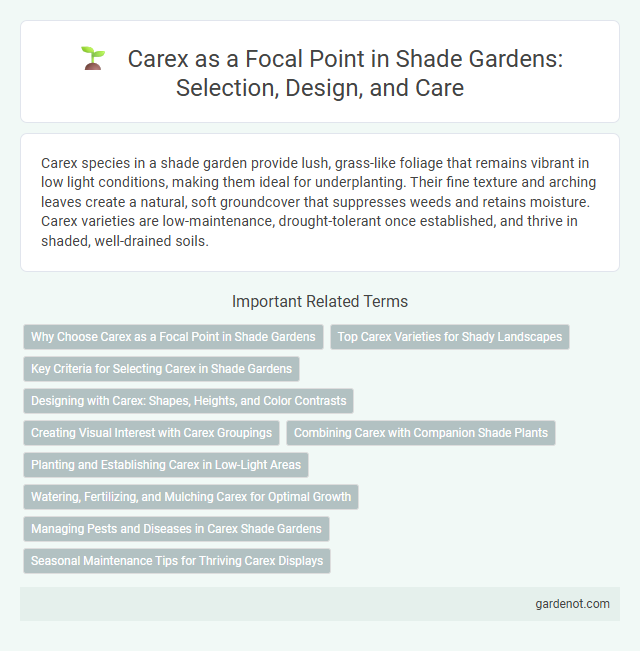Carex species in a shade garden provide lush, grass-like foliage that remains vibrant in low light conditions, making them ideal for underplanting. Their fine texture and arching leaves create a natural, soft groundcover that suppresses weeds and retains moisture. Carex varieties are low-maintenance, drought-tolerant once established, and thrive in shaded, well-drained soils.
Why Choose Carex as a Focal Point in Shade Gardens
Carex species thrive in low-light environments, making them ideal focal points for shade gardens. Their diverse textures and vibrant green hues create visual interest and contrast amidst darker foliage. Carex also offers low maintenance and year-round structure, enhancing garden aesthetics even in off-seasons.
Top Carex Varieties for Shady Landscapes
Carex varieties thrive in shady gardens, providing lush, grass-like foliage with excellent texture and year-round interest. Popular top Carex selections for shady landscapes include Carex morrowii 'Ice Dance' with variegated leaves, Carex oshimensis 'Evergold' for bright yellow stripes, and Carex elata 'Aurea' known for its vibrant golden hue. These shade-tolerant sedges offer low maintenance, excellent ground cover, and erosion control, enhancing both garden aesthetics and functionality.
Key Criteria for Selecting Carex in Shade Gardens
Selecting Carex for shade gardens requires focusing on shade tolerance, ensuring the species thrives with limited sunlight and maintains vibrant foliage. Prioritize moisture preferences, as many Carex varieties prefer consistently moist, well-drained soils to support healthy growth. Consider height and texture diversity to complement other shade garden plants and enhance overall landscape interest.
Designing with Carex: Shapes, Heights, and Color Contrasts
Carex varieties offer diverse shapes, from fine, arching blades to dense, tufted forms, making them ideal for dynamic shade garden designs. Their varying heights, typically ranging from 6 inches to over 3 feet, provide layered textural interest and natural screening options. The rich green, blue, and bronze foliage creates striking color contrasts that enhance depth and visual appeal in shaded landscapes.
Creating Visual Interest with Carex Groupings
Carex groupings create dynamic visual interest in shade gardens through their diverse foliage textures and rich green hues. Their graceful, arching blades form elegant patterns that contrast beautifully with broadleaf plants, enhancing garden depth and movement. Varieties like Carex morrowii and Carex oshimensis add year-round structure and subtle color variation, making them ideal for layered shade compositions.
Combining Carex with Companion Shade Plants
Carex thrives in shaded environments, pairing exceptionally well with hostas and ferns to create textured foliage contrasts. Its fine, arching blades complement the broad leaves of astilbe, enhancing visual interest in shade gardens. Moist, well-drained soil promotes healthy growth when combined with shade-loving companions that share similar light and water requirements.
Planting and Establishing Carex in Low-Light Areas
Carex thrives in low-light shade gardens by preferring moist, well-drained soil with consistent watering during establishment. Planting Carex in early spring or fall ensures root development before heat stress occurs, enhancing survival and growth. Mulching around the base helps retain soil moisture and suppress weeds, supporting healthy establishment in shaded environments.
Watering, Fertilizing, and Mulching Carex for Optimal Growth
Carex thrives in consistently moist, well-drained soil, requiring regular watering to prevent drought stress, especially during dry spells. Applying a balanced, slow-release fertilizer in early spring promotes vigorous growth and deep green foliage. Mulching with organic materials such as leaf litter or bark mulch helps retain soil moisture, regulate temperature, and suppress weeds for optimal Carex development in shade gardens.
Managing Pests and Diseases in Carex Shade Gardens
Carex species in shade gardens exhibit strong resistance to common pests such as aphids and spider mites, reducing the need for chemical treatments. Proper air circulation and well-drained soil prevent fungal diseases like rust and powdery mildew, which can occasionally affect dense Carex clumps. Regular inspection and removing affected foliage help maintain plant health and ensure vibrant, pest- and disease-free shade garden beds.
Seasonal Maintenance Tips for Thriving Carex Displays
Carex thrives in shade gardens when provided with consistent moisture and well-draining soil to prevent root rot during wet seasons. Regular removal of dead or damaged foliage in early spring encourages healthy growth and vibrant seasonal displays. Dividing clumps every 3 to 4 years maintains plant vigor and promotes dense, lush foliage throughout the growing season.
Carex feature Infographic

 gardenot.com
gardenot.com